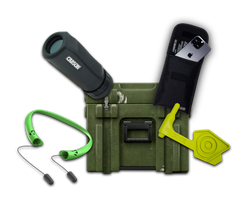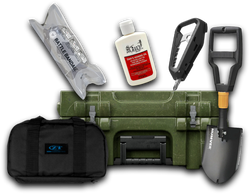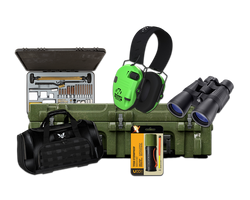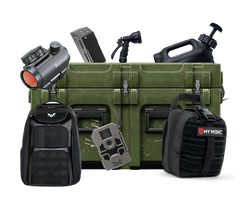What is a Falling Block Rifle?
Table of Contents
- Introduction
- The Mechanics of the Falling Block Action
- Historical Context and Evolution
- Advantages of Falling Block Rifles
- Notable Models and Manufacturers
- Modern Uses and Applications
- Care and Maintenance Tips
- FAQs
- Conclusion
Introduction
Imagine standing in the serene wilderness, rifle in hand, poised to take a shot at a majestic elk grazing peacefully in the distance. As you prepare to fire, you rely not just on your skill but also on the quality and reliability of your weapon. Among the various types of firearms, the falling block rifle stands out for its unique mechanism and robust design, boasting a rich history that intertwines with the evolution of rifle technology.
So, what exactly is a falling block rifle? At its core, a falling block rifle is a type of single-shot firearm that utilizes a specific mechanical action where the breechblock drops down to allow for reloading and extraction of spent cartridges. This action is not only effective but also offers a level of strength and reliability that has made it a favorite among hunters and marksmen.
In this blog post, we will delve into the intricacies of falling block rifles, exploring their design, functionality, historical significance, and the modern examples still utilized today. By the end, you'll possess a comprehensive understanding of this fascinating firearm, its advantages, and why it continues to be a popular choice among tactical enthusiasts and hunters alike.
We will cover the following topics:
- The Mechanics of the Falling Block Action
- Historical Context and Evolution
- Advantages of Falling Block Rifles
- Notable Models and Manufacturers
- Modern Uses and Applications
- Care and Maintenance Tips
- FAQs
Join us as we embark on a journey through the world of falling block rifles, shedding light on their enduring legacy and relevance in today’s firearms landscape.
The Mechanics of the Falling Block Action
A falling block rifle operates through a simple yet effective mechanism. The action is characterized by a solid metal breechblock that slides vertically within grooves in the receiver. When the shooter operates the lever, the breechblock drops, exposing the chamber for cartridge loading or spent case extraction.
Key Components
-
Breechblock: The heart of the falling block action, this component seals the chamber to contain the pressure produced when a cartridge is fired. Its design ensures that the rifle can handle high-pressure rounds safely.
-
Lever Mechanism: Typically situated near the trigger guard, the lever is what the shooter engages to drop the breechblock. This lever action is intuitive and allows for quick reloading.
-
Receiver: The receiver houses the entire action and provides the structural integrity of the rifle. When the breechblock is closed, the receiver becomes a solid piece, enhancing strength and stability.
-
Trigger and Hammer: These components, like in most rifles, serve to ignite the primer of the cartridge, enabling the projectile to be fired.
Functionality
When the breechblock is in the closed position, it effectively seals the chamber against the high pressures generated during firing. Once the shot is fired, the shooter can operate the lever, allowing the breechblock to drop, which exposes the chamber for the extraction of the spent cartridge and the insertion of a new round. This unobstructed loading path is especially advantageous for long cartridges, making falling block rifles ideal for high-caliber ammunition.
Comparison with Other Actions
Falling block rifles differ significantly from other common actions like bolt-action or lever-action rifles. Unlike bolt-action rifles that utilize a rotating bolt to lock the chamber, falling block actions provide a straightforward approach with fewer moving parts, which can enhance reliability.
The simplicity of the falling block mechanism also reduces the potential for mechanical failure, making it a robust choice for both hunting and target shooting.
Summary
The mechanics behind the falling block rifle action provide a unique blend of reliability and strength. The lever-operated breechblock mechanism allows for efficient reloading and extraction, making it a preferred choice among marksmen who value precision and durability.
Historical Context and Evolution
The history of the falling block rifle is as rich as the landscapes they are often used in. Their design evolved significantly throughout the 19th century, a period marked by rapid advancements in firearm technology.
Early Innovations
The concept of the falling block action can be traced back to the early 1830s, with notable patents filed by inventors such as J.F. Jobard in Belgium. Jobard's design utilized a self-contained cartridge, a revolutionary idea at the time. This advancement laid the groundwork for the development of many subsequent falling block rifles.
The 19th Century: A Turning Point
The late 1800s saw the proliferation of falling block rifles, with several models gaining prominence. Among these were:
-
Sharps Rifle: Known for its accuracy and powerful cartridges, the Sharps rifle became iconic during the American Civil War and the subsequent westward expansion.
-
Martini-Henry: Adopted by the British Army, this rifle played a crucial role in various conflicts, showcasing the effectiveness of the falling block design in military applications.
As the 19th century progressed, the falling block rifle was increasingly embraced for both military and civilian use, particularly in hunting large game. The ability to handle powerful cartridges without compromising safety contributed to their popularity.
Transition to Modernity
As the 20th century approached, the falling block rifle began to face competition from faster-loading bolt-action and semi-automatic designs. Despite this, the falling block mechanism was not entirely relegated to history. Manufacturers began to innovate, producing modern variants that retained the classic charm and functionality of their predecessors.
Summary
The historical evolution of the falling block rifle reflects a dynamic interplay between technological advancement and practical application. From its early beginnings to its adoption in military and civilian contexts, the falling block rifle has demonstrated both resilience and adaptability.
Advantages of Falling Block Rifles
Falling block rifles offer several distinct advantages that continue to make them a popular choice among shooters and hunters. Understanding these benefits can help you appreciate why enthusiasts remain loyal to this design.
Strength and Durability
One of the standout features of falling block rifles is their robust construction. The solid metal breechblock creates a strong seal when closed, allowing the rifle to withstand high-pressure rounds. This durability is particularly appealing to those who frequently use powerful cartridges.
Accuracy
Falling block rifles are renowned for their precision. The design allows for a consistent lock-up, minimizing any movement between the barrel and action during firing. This leads to improved accuracy, making it a favored option for target shooting and hunting.
Versatility
The unobstructed loading path of falling block rifles accommodates a wide range of cartridge lengths. This versatility is especially beneficial for hunters who may wish to use specialized or custom ammunition for specific game.
Simplicity of Operation
The lever action mechanism is straightforward and intuitive. Unlike more complex mechanisms that may require extensive training, falling block rifles are easy to operate, making them suitable for both novice and experienced shooters.
Historical Appeal
For many firearm enthusiasts, there’s a nostalgic charm associated with falling block rifles. Their rich history and classic designs evoke a sense of tradition and craftsmanship that resonates with those who appreciate the art of shooting.
Summary
The advantages of falling block rifles lie in their strength, accuracy, versatility, and ease of use. These traits make them an enduring choice for those who value quality and performance in their firearms.
Notable Models and Manufacturers
Falling block rifles have been produced by a variety of manufacturers over the years, each contributing unique models that have become iconic in their own right. Let’s take a closer look at some of the most notable falling block rifles and the companies that produce them.
Ruger No. 1
The Ruger No. 1 is perhaps one of the most recognized modern falling block rifles. With its sleek design and robust performance, it has gained a loyal following among hunters and target shooters alike. Available in a variety of calibers, the No. 1 is versatile and well-suited for various shooting applications.
Sharps Rifle Company
The Sharps rifle remains a classic example of the falling block action. Originally designed in the 1850s, the Sharps rifles have seen numerous reproductions and modern iterations that continue to draw interest from collectors and shooters. Its historical significance and performance make it a sought-after model.
Winchester Model 1885
The Winchester Model 1885, also known as the High Wall, is another iconic model that has stood the test of time. Known for its strength and accuracy, the Model 1885 has been popular among target shooters and hunters for over a century.
Browning Model 1885
Similar to the Winchester, the Browning Model 1885 offers a contemporary twist on the classic falling block design. Its combination of modern materials and traditional craftsmanship appeals to a wide range of shooters looking for a reliable and accurate rifle.
Summary
Notable models like the Ruger No. 1, Sharps rifle, and Winchester Model 1885 highlight the diversity and continued relevance of falling block rifles. Each model brings its own unique features and historical significance, catering to the needs of various enthusiasts.
Modern Uses and Applications
Despite the rise of more advanced firearm technologies, falling block rifles continue to occupy a niche in the shooting community. Their versatility makes them suitable for various applications, including:
Hunting
Falling block rifles are frequently used for hunting big game due to their ability to handle powerful cartridges. Whether tracking elk in the Rockies or hunting deer in the Midwest, the precision and strength offered by these rifles make them a top choice among hunters.
Target Shooting
Many shooters appreciate falling block rifles for their accuracy and consistency, making them ideal for target shooting. The simplicity of the mechanism allows shooters to focus on their technique without the distraction of complex actions.
Collecting
For collectors, falling block rifles represent a blend of history and craftsmanship. Vintage models, particularly those produced by renowned manufacturers, can be valuable additions to any collection.
Specialty Applications
Some modern falling block rifles are designed for specialized applications, such as long-range shooting or competition. Their ability to accommodate a wide range of cartridges allows for flexibility in custom ammunition choices.
Summary
Falling block rifles remain relevant in modern shooting contexts, with applications in hunting, target shooting, collecting, and specialized uses. Their versatility ensures they continue to appeal to a broad audience of tactical enthusiasts and firearms aficionados.
Care and Maintenance Tips
To ensure optimal performance and longevity of your falling block rifle, proper care and maintenance are essential. Here are some best practices for keeping your rifle in top condition:
Regular Cleaning
After each use, it’s crucial to clean the rifle to remove any residue from the firing process. Use a cleaning rod and appropriate brushes to clean the barrel, ensuring that any fouling is effectively removed. A clean barrel ensures accuracy and prevents corrosion.
Lubrication
Apply a light coat of gun oil to the moving parts of the action to keep them functioning smoothly. Avoid over-lubricating, as excess oil can attract dirt and debris.
Inspect for Wear
Regularly inspect your rifle for any signs of wear or damage. Pay attention to the breechblock and lever mechanism, as any issues in these areas can affect performance. If you notice any problems, consult a professional gunsmith for repairs.
Store Properly
When not in use, store your falling block rifle in a cool, dry place. Utilize a quality gun case to protect it from moisture and physical damage. Consider investing in a dehumidifier for long-term storage in humid environments.
Use Quality Ammunition
To maintain the integrity of your falling block rifle, always use high-quality ammunition. Subpar rounds can lead to malfunctions and can even damage the firearm over time.
Summary
By following these care and maintenance tips, you can ensure that your falling block rifle remains in peak condition, providing reliable performance for years to come.
FAQs
What is the main advantage of a falling block rifle?
The main advantage of a falling block rifle is its robust construction, which allows it to handle high-pressure cartridges safely, while also providing exceptional accuracy and ease of use.
Are falling block rifles suitable for hunting?
Yes, falling block rifles are well-suited for hunting, especially for big game due to their ability to handle powerful cartridges effectively.
How does a falling block rifle compare to a bolt-action rifle?
Falling block rifles offer a simpler mechanism with fewer moving parts compared to bolt-action rifles. They are often praised for their accuracy and reliability, making them a popular choice among shooters.
Can falling block rifles be used for target shooting?
Absolutely! Many enthusiasts enjoy using falling block rifles for target shooting due to their precision and unique action.
What are some modern manufacturers of falling block rifles?
Notable modern manufacturers include Ruger, Winchester, and Browning, each offering their own versions of the classic falling block design.
How should I maintain my falling block rifle?
Regular cleaning, lubrication, inspection for wear, and proper storage are key practices for maintaining your falling block rifle in optimal condition.
Conclusion
Falling block rifles embody a blend of historical significance and modern functionality that appeals to both tactical enthusiasts and hunters alike. With their robust construction, impressive accuracy, and ease of use, these rifles have carved out a niche in the firearms world that continues to thrive today.
From their mechanical intricacies to their applications in hunting and target shooting, falling block rifles present a unique experience for those who appreciate quality craftsmanship and precision. As you consider your next rifle purchase or delve deeper into the world of firearms, remember the value and legacy of falling block rifles.
For those looking to enhance their tactical gear and preparedness, Crate Club offers a subscription service that delivers carefully curated tactical gear and survival tools each month. Check out the Crate Club Subscription Services here and explore their extensive selection of products in the Crate Club Shop here.
As you continue your journey in the shooting community, consider the timeless appeal of the falling block rifle and how it can enrich your experience in the great outdoors. Whether you're a seasoned marksman or a novice shooter, the falling block design has something to offer everyone.
Share this article



